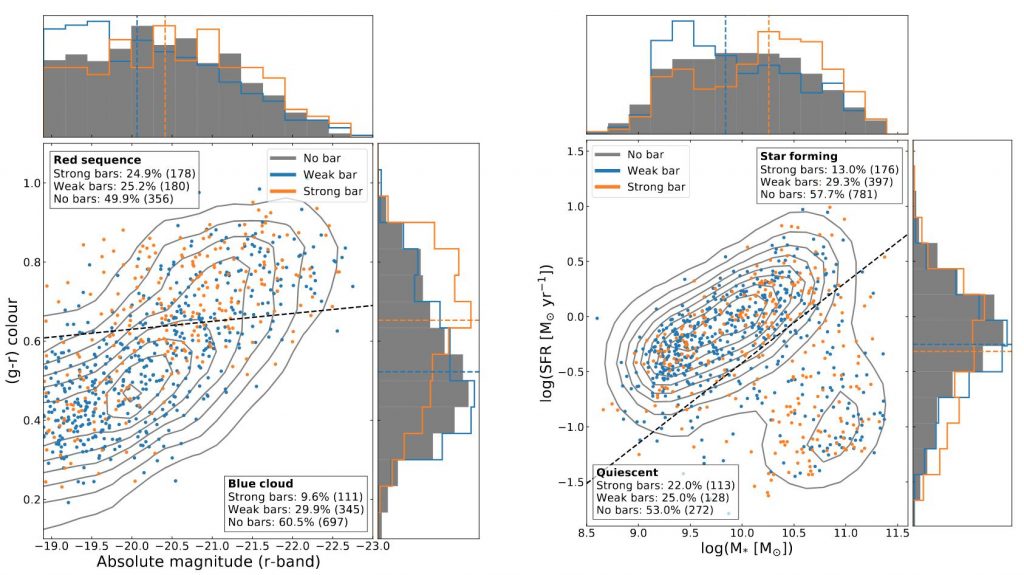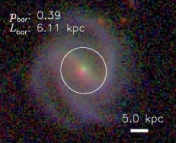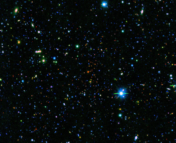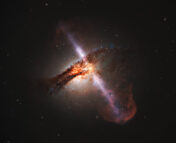Title: Galaxy Zoo: Stronger bars facilitate quenching in star forming galaxies
Authors: Tobias Géron, R. J. Smethurst, Chris Lintott, Sandor Kruk, Karen L. Masters, Brooke Simmons and David V. Stark
First Author’s Institution: Department of Physics, University of Oxford, Oxford, UK
Status: Accepted in MNRAS (open access on arXiv)
Gaze up at a clear night’s sky, and you might be lucky enough to spot the Large Magellanic Cloud (LMC), a dwarf spiral galaxy around 50 kpc away and one of several companion galaxies orbiting our Milky Way. The LMC features an off-centre bar; a rectangular structure containing a high concentration of stars. The Milky Way also contains a bar. Indeed, many spiral galaxies (current estimates range from 30% to 56%) are barred galaxies, and the overall fraction of barred galaxies is rising. Understanding how bars are formed, and how they interact with their host galaxy, is crucial to understanding the overall processing governing galaxy evolution. Today’s paper offers some insights into the nature of galactic bars, and the role they play in regulating galaxy growth. In it, the authors utilise the Galaxy Zoo DECaLS (GZD) survey to identify and study strong and weak barred galaxies. The authors find that strong bars facilitate a strong reduction in star formation activity, a process known as “quenching”.
To Bar or Not To Bar
Through numerical simulations (such as this), bars are known to have dramatic effects on the dynamical and chemical evolution of galaxies, including affecting the star formation rate (SFR). In particular, the torque generated by bars as they rotate can both funnel gas towards the centre of galaxies, and push gas outwards. This can result in starbursts – brief periods of intense star formation activity – followed by a sustained decay in overall star formation as the gas is rapidly depleted. One of the mysteries of bars can be likened to the “chicken and the egg” problem. Bars are more likely to be observed in redder, more massive and more gas-poor galaxies (i.e. so-called “red and dead” or quiescent galaxies). This begs the following question: do bars quench galaxies and turn them into gas-poor ones, or are bars simply easier to form in gas-poor galaxies? Did the bar or quenching come first?
Strong vs. Weak
To answer this, the authors analysed a subsample of 1,867 galaxies from the GZD survey, crossmatched with spectra from the Sloan Digital Sky Survey (SDSS) and HI measurements from the ALFALFA survey. These galaxies were classified by volunteers as either weakly or strongly barred (depending on the relative prominence of the bar), or instead containing no bar at all. Figure 1 shows some example barred galaxies, with bars of varying lengths (in kpc) from weak to strong.

Previous studies have established that bars are more common in redder, more massive and more quiescent galaxies. However, the authors of this study find that this is only the case for strong bars. Figure 2 shows that strong bars are more common at redder colours (higher values of g-r), peak at higher masses and, in general, have lower levels of star formation activity as compared to weaker bars. Conversely, weak bars are more common in low-mass, “blue” galaxies (i.e. galaxies still actively star forming).

The Dying of the Light
Figure 3 contains the colour magnitude diagram and SFR-stellar mass plane for these galaxies. The fraction of strong bars is significantly higher in both the red cloud and quiescent populations (compared to the blue cloud and star forming populations), while the percentage of weaks bars differs only slightly. Most importantly, however, is the fact that the weak bar fraction is the same in the red cloud and in quiescent galaxies (25.2% and 25%), as well as in the blue cloud and star forming galaxies (29.9% and 29.3%). The strong bar fractions do not display this correspondence. We are back at the previous conundrum? Do strong bars quench galaxies, or are strong bars more easily formed in quenched galaxies?

The authors argue in favour that strong bars quench galaxies. This is since only the star-forming strong bars show a statistically significant difference in terms of a greater overall star formation rate and shorter gas depletion times, even when compared to a weak or unbarred galaxy of the same mass. Furthermore, none of the quiescent galaxies, regardless of whether they were barred or unbarred, exhibited such a major difference. Thus the authors conclude that, on average, strong bars are responsible for quenching galaxies.
Not so different after all
Given the clear distinctions made between weak and strong bars, it’s tempting to conclude that they must be fundamentally different. Is this truly the case? One way to analyse this is to consider bar length. If strong and weak bars were distinct phenomena, then at a given, fixed bar length, they should exhibit fundamentally different behaviour. Surprisingly, although star forming strong bars have higher fibre SFRs compared to star forming weak bars, when instead plotted as a function of bar length (Figure 4), the values are almost exactly the same. In other words, at a fixed bar length, strong and weak bars are indistinguishable. Thus the authors propose that strong and weak bars are not inherently different. Instead, it is more appropriate to treat bars as a continuum, whereby the terms “strong” and “weak” can be considered its extremes. In this sense, the effect a bar has on its host galaxy depends on where it lies on this continuum.

Strong bars before quenching
The problem of whether bars are the ultimate galaxy killers, or are instead more easily formed in red and dead galaxies, has long been a mystery. Thanks to the GZD survey, and the many volunteers who classified strong and weak bars, this paper proposes that bars do quench galaxies, but it is only the strongest bars that are directly responsible. Only strong bars in star forming galaxies have comparatively higher rates of star formation and subsequently deplete gas more quickly. Furthermore, this study suggests that bars are better thought of as a continuum of types, rather than as a disparate, binary “strong vs. weak” distinction. In this sense, strong and weak bars are not fundamentally different, but are instead manifestations of the same underlying phenomena. There is still much more to learn about the nature of bars, and with the help of more detailed galaxy surveys honing in on their properties, their secrets are sure to be revealed.
Featured image credit: Astrobin (NGC 1291)
Astrobite edited by: Zili Shen




